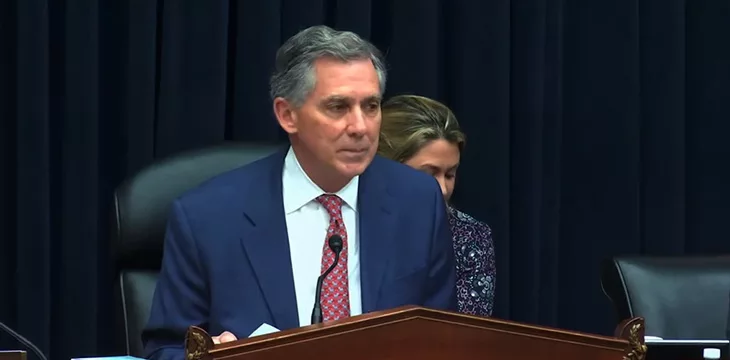|
Getting your Trinity Audio player ready...
|
Stablecoins were front and center in a U.S. congressional hearing Wednesday, and some of the opinions voiced were more than a little unstable.
On Wednesday, the House of Representatives’ Financial Services Committee held a hearing titled “Understanding Stablecoins’ Role in Payments and the Need for Legislation.” The hearing was preceded by last weekend’s surprise release of a 73-page discussion draft of “a bill to provide requirements for payment stablecoin issuers, research on a digital dollar, and for other purposes.”
The draft was largely ignored during Wednesday’s hearing in favor of a broader stablecoin debate, so we’ll briefly run through the more salient elements. These include the effort to distinguish between a ‘payment stablecoin’ and the casino chips used in the utility-free exchange model. (The latter is the only stablecoin in use today.)
The draft defines payment stablecoin as “designed to be used as a means of payment or settlement” but isn’t a national currency or a security issued by an investment company. The issuer must “convert, redeem or repurchase” stablecoins for “a fixed amount of monetary value.” The issuer must also create a “reasonable expectation” that its coins will maintain “a stable value relative to the value of a fixed amount of monetary value.”
Payment stablecoin issuers must be approved by either a “federal payment stablecoin regulator” or “a registered State qualified payment stablecoin issuer.” State issuers must file a “registration statement” with the Federal Reserve’s Board of Governors. The Fed can delegate some of its responsibilities to its state counterparts, who can set additional standards if consistent with the Fed’s rules.
The Federal regulator’s hands would be tied somewhat, as the draft gives them only 90 days after receiving a “complete” application to process the said application. Failure to render a decision within that 90-day window would result in automatic approval of the application.
Redemption requests must be honored “no longer than one day” after such requests are made. The reserves backing issued stablecoins would have to be kept in cash, Treasury bills with a maturity of 90 days or less, repurchase agreements with a maturity of seven days or less that are themselves backed by 90-day T-bills, or central bank reserve deposits.
Stablecoin issuers would be required to publish monthly data on the composition of their reserve portfolio, with CEOs responsible for filing monthly attestations regarding the accuracy of this information. Issuers with over $150 million of stablecoins in circulation must also file annual reports.
Rehypothecation of reserves—the kind of antics that got bankrupt entities such as Celsius into so much trouble—would be out of bounds “except for the purpose of creating liquidity to meet reasonable expectations” for redemption requests (subject to certain conditions, including prior approval by federal regulators).
Both bank and non-bank entities would be permitted to issue stablecoins. Both would be eligible for access to the Fed’s master accounts and the discount window (Fed loans to depository institutions).
However, the draft also claims that payment stablecoins “are not backed by the full faith and credit of the United States, guaranteed by the United States Government, subject to deposit insurance by the Federal Deposit Insurance Corporation, or subject to share insurance by the National Credit Union Administration.” There will be penalties for anyone misrepresenting the above caveats.
Federal and state authorities may craft standards “to promote compatibility and interoperability … that enable participants in one payment system to clear and settle payments across payment systems without participating directly in multiple payment systems.”
The draft also addresses “endogenously collateralized stablecoins,” aka ‘algorithmic’ stablecoins like Terraform Labs’ ill-fated UST. Should the bill become law, there will be a two-year period in which it will be illegal to create an endogenously collateralized stablecoin “not in existence” at the time the law is enacted.
Finally, the bill calls for yet another study of the impact of a U.S. central bank digital currency (CBDC), including what effect such a ‘digital dollar’ might have on the stablecoin market.
Opening remarks
Wednesday’s hearing was far shorter (thank God) and featured fewer committee members than Tuesday’s marathon grilling of Securities and Exchange Commission (SEC) Chairman Gary Gensler. Seems dry legislative text offers less opportunity for performative yelling.
Rep. French Hill (R-AR) got things rolling by reminding everyone of the bipartisan stablecoin bill that was introduced in the previous Congress but died with last November’s mid-term elections. Hill called the current discussion draft “an infant and not necessarily a beautiful baby, but it’s our baby.” High praise, indeed.
Hill said the draft aimed to build on the stablecoin report issued in November 2021 by the President’s Working Group. Hill said there was a need to end the ongoing “turf war” between the SEC and the Commodity Futures Trading Commission (CFTC) over who gets to regulate digital assets because, absent an act of Congress, these agencies will “interpret their mandates broadly.”
Hill was followed by Rep. Stephen Lynch (D-MA), whose initial statement referenced the “abrupt demise of Tether,” which sent many of us scurrying to Google (NASDAQ: GOOGL) in search of updates. Lynch later apologized, revealing he meant to say, Terra. (But rest assured, the Tether Ponzi’s time is coming.)
Addressing the legislation, Lynch observed that stablecoins were rarely used for payments but were the main conduit for “speculative crypto trading and investments.” Given that reality, Lynch questioned whether there was any legitimate need for stablecoins, particularly if it allowed non-bank entities to issue “bank-like products.”
Lynch took issue with the proposal that the federal government effectively leave stablecoin issuer approvals up to the states, which he claimed would allow issuers to “avoid federal oversight.” Lynch also expressed unease that the bill might expose the banking system to greater risks from which it was previously “ring-fenced.”
Rep. Patrick McHenry (R-NC) thanked ranking member Maxine Waters (D-CA) for her work on the Toomey bill in the previous Congress. But Waters retorted that she’d been “alarmed” when, instead of taking last year’s bill as their common starting point, McHenry had “come up with a whole new bill.”
This suggested to Waters that Republicans had “come to the negotiations with their minds already made up” and that she’d respond by introducing her own stablecoin bill and forcing the two drafts to Thunderdome it out. Waters suggested the best course of action was to “disregard” the new GOP-favored bill “altogether.” So, yeah. Promising start.
Let’s meet our panel
Adrienne Harris, Superintendent of the New York Department of Financial Services (NYDFS), kicked off the witness testimony portion. (Read Harris’ prepared remarks here.) Harris noted that her agency had led the way in state-level digital asset oversight, including the release of the first state-level stablecoin guidance last summer.
Harris noted that the feds and the states had managed to maintain a “well-established dual-banking system” and, while she supported establishing a national framework for stablecoin regulation, she nonetheless urged the committee not to “hamstring” state regulators.
Next up was Zero Knowledge Consulting’s Austin Campbell, who, until last December, worked for New York-based stablecoin issuer Paxos. (Prepared remarks here.) Campbell claimed the state of U.S. digital asset regulations was like being invited to play a game of football, but the referees would enforce basketball rules, and possibly rules from other sports, but you wouldn’t be told which ones in advance.
Campbell claimed this “chaos” was forcing “good actors” to shift their operations to other jurisdictions that offered more clarity. Campbell further claimed that Tether was the biggest beneficiary of this chaos. Campbell also suggested that, while states could oversee smaller stablecoins, larger “systemic” coins would require federal oversight.
Blockchain Association policy officer Jake Chervinsky (prepared remarks here) played the national security card, saying stablecoins would help re-establish U.S. dollar dominance at a time when China was actively undermining USD. Chervinsky claimed that U.S. financial services were “stuck in the 20th century” and updating them would “send a message that innovators are welcome.”
Then there was Dante Disparte, Chief Strategy Officer at Circle, an issuer of the USDC stablecoin. (Prepared remarks here.) USDC appears to be the primary beneficiary of the proposed legislation, not surprising given Circle’s efforts to popularize the ‘payments stablecoin’ designation. Disparte also played the patriotism card, saying greater USDC adoption would help ensure USD dominance, “including natively on the internet.”
Finally, Consumer Reports’ Director of Financial Fairness Delicia Reynolds Hand said in her prepared statement that it was “still an open question” whether digital assets were living up to their hype. She also warned that the draft bill could create the potential for “regulatory arbitrage” if stablecoin issuers played states against each other and the Fed could not reject state licenses.
She stressed that “being able to prevent, cancel, replace, or override a transaction is a critical function necessary to ensure payment system operators are able to conduct chargebacks or facilitate disputes over payments.” (She didn’t specifically mention the Bitcoin token recovery process, but we will!)
Q&A
Lynch queried Reynolds Hand regarding the risks that stablecoins might present to the traditional banking system, leading her to say she’d like to see “clear activity limitations,” including on commingling of customer funds, self-dealing and undisclosed conflicts of interest. Citing the Celsius debacle, Reynolds Hand stressed the need to avoid a “debtor-creditor relationship, so that my coins are my coins, not those of the company.”
Lynch noted that one of the few positives from last year’s ‘crypto collapse’ was that it failed to “infect” the traditional banking system because “crypto” was ‘ring-fenced.’ Reynolds Hand added that America’s National Bank Act was a response to regional bank failures, which stemmed from a lack of federal oversight. “We cannot treat non-bank entities like banks without the equivalent restrictions.”
Rep. Frank Lucas (R-OK) put Disparte on the spot by referencing USDC losing its 1:1 peg with the dollar following last month’s collapse of Silicon Valley Bank, at which Circle kept $3.3 billion of USDC’s cash reserves in an uninsured account. Lucas remarked that regulators saved Circle’s bacon by “stepping in to insure deposits” and wondered what lessons Circle learned from this near-death experience.
Disparte deflected, saying the lessons learned included the belief that “we had to protect our business from the risks of banking.” Acknowledging that the de-pegging “could have been an existential event,” Disparte claimed Circle was able to meet the ensuing flood of redemption requests, albeit “the Saturday after the bank failures began.” That allowed USDC to claw back from its 88¢ level to 98¢ (which really isn’t the flex that Disparte appeared to think it is).
Waters asked Harris for her opinion on what constitutes “credible” assets in stablecoin reserves. Harris urged the committee to do what it could to “duplicate” New York’s regime and “allow for a state pathway so that nimble regulators can continue to police the space appropriately.”
Harris added that “no New York-licensed entity has gone bankrupt,” citing FTX, Voyager, and Celsius as companies that failed to secure NYDFS licenses because “they did not meet our standards.”
Tether time bomb
Rep. Warren Davidson (R-OH) asked Campbell why Tether—which he called a “time bomb”—had established such dominance over the stablecoin market. Campbell said Tether had launched in 2014 and thus enjoyed a “first-mover advantage.” Campbell believes this “speaks to the problem of [regulatory] inaction” leading to “entrenched incumbents.”
Campbell further claimed that Tether has “not faced the same type of regulatory uncertainty. They don’t have the concerns that others do about conforming to something relatively strict and demanding, like the NYDFS guidance.” Ultimately, Tether is “what people use because there’s demand for dollars on blockchain. It’s there just because it’s been available.”
Davidson asked Chervinsky if stablecoins needed to “retain aspects of cash” to be used as a medium of exchange, citing the choice between direct peer-to-peer transfers versus going through an intermediary. Chervinsky said it was “absolutely critical” to “reproduce the benefits of cash” rather than follow China’s model of a currency “totally controlled and surveilled by governments” or a corporate model of “surveillance capitalism.”
Gun to your head
Rep. Bill Foster (D-IL) went on a bit of a tangent, demanding to know what blockchain firms could do to minimize the fallout from crypto-related crime. When Chervinsky tried to speak about initiatives that firms were developing for the future, Foster cut him off, saying that “not acceptable. We need it now.”
Foster declared, “either you support continuation of ransomware and all that illicit stuff or you don’t. It’s pretty much a binary choice. I don’t believe U.S. citizens want to live in a world [of] anonymous transactions.” Citing the example of someone getting dragged into an alley, having a gun stuck in their face, and being told to get out their phone and “transfer all of your digital assets to me,” Foster asked the panel: “Are you screwed or not?” (I think we’ll play our Bitcoin token recovery card again.)
Campbell said stablecoins on public blockchains should have “freeze and seize capabilities.” Campbell added that “we also need blockchain surveillance tools.” Foster wanted to know if Campbell was talking about mandatory transparency that would allow regulators to know the identities behind every transaction. Campbell said “that’s one option.”
Foster suggested what was needed was “the equivalent of a license plate on every digital wallet … it would be completely unacceptable to have unlicensed cars driving through your neighborhood … when someone runs over your dog, you can jot down the license plate, take it to a trusted court system, de-anonymize the owner and haul them into court.”
Campbell said he doesn’t need to know who owns a wallet to take stolen assets from that wallet. Foster clarified that this requires “some kind of governance … a trusted third party that can reverse transactions.” Campbell was forced to agree.
States, right?
Rep. Ritchie Torres (D-NY) went to bat for the NYDFS, saying he won’t support any stablecoin legislation that encroaches on his state’s oversight. Torres asked Harris whether she had any concerns with the draft bill and she noted that while the text says “nothing in this legislation will pre-empt states in practice, I think there are a number of provisions [she didn’t specify which] that give federal regulators veto authority over state regulators.”
Rep. Sean Casten (D-IL) painted a less flattering portrait of allowing states complete freedom to allow non-bank entities to issue stablecoins. Citing Detroit’s 2013 bankruptcy, Casten wondered if state residents would have objected to Michigan’s state government “printing paper money pegged to the dollar with a federal backstop.”
Casten suggested this was a way for cash-strapped states to “dump risk on the U.S. taxpayer.” He got some support from Reynolds Hand, who agreed that the federal government needed the ability to reject states (quite literally) passing the buck.
Fire and brimstone
We’ll close with a truly fiery performance by Rep. Brad Sherman (D-CA), who claimed “the crypto world makes money by literally making money,” much of which goes to “lobbyists and propaganda.”
Sherman remarked that the L.A. Lakers “play at Crypto[.com] Arena, they do not play at KYC [Know Your Customer] Arena. They do not play at Enforce Our Tax Laws Arena. They do not play at Prevent Drug Dealers From Being Able To Get Their Financial Transactions Arena.”
Sherman proceeded to list the virtues of America’s existing payment systems, which are “not as good as what the crypto world promises to deliver in some future decade, but it’s better than what crypto does now … So what is the problem? The problem is it’s damn hard to cheat on your taxes and run a drug-sales operation with the U.S. dollar. Because we’ve got know your customer and anti-money laundering.”
Sherman went on to offer what he sees as crypto’s latest FOMO mantra about ‘innovators’ moving overseas in pursuit of less stringent oversight: “Peru’s ahead of us in cocaine cultivation. China’s ahead of us in organ harvesting. It’s time for America to catch up!”
Sherman concluded that stablecoins are only necessary so criminals can ensure that the billions they’ve stolen are protected, rather than vanishing into thin air following some unfortunate incident in the Bahamas. At the end of the day, criminals want to know if there’s actually reserves backing their coins. “Drug dealers need regulation too. A fair system to have a concealed currency is what cryptocurrency is all about.”
Watch: Digital Asset Recovery Process on Bitcoin

 12-17-2025
12-17-2025 




